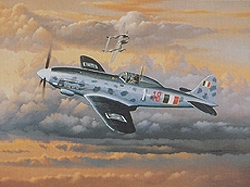|
|
| Italian Air Stallion |
|
 |

|
 |
|
|
| DESCRIPTION |
 |
| 16 x 11.5 Inch Collector Size Unframed Lithograph $40.00
The Italian campaign was conceived as a way to strike at Hitler's "soft underbelly" and obtain necessary airfields and port facilities to assist in the eventual invasion of Europe by the Allies. In July of 1943 while Allied forces were smashing resistance in Sicily, Mussolini plotted strategy with Hitler near Rimini. One week later Mussolini was arrested and King Victor Emmanuel took control of the Italian Armed Forces. By September the King had negotiated Italy's surrender, but the Germans strengthened their forces in northern and central Italy leading to a long and difficult campaign of liberation for the Allied forces. In a country with many mountains and poor roads, air power played a major role. Little has been written about Major Adriano Visconti who was Italy's highest scoring ace in WW II. Visconti flew as a reconnaissance pilot in Libya in 1940. Later he was assigned to the 7th and 16th Gruppo of the 54th Stromo C.T. Flying over Malta in 1941 and 1942 Visconti downed two RAF Hurricanes and 2 Bristol Blenheims. Later in fighting over Tunisia and Sicily, Visconti was credited with 14 more victories. When Italy surrendered in September of 1943, Visconti flew north in his Macchi 205 fighter crammed with three ground personnel. He joined the air forces of the newly organized New Fascist Republica Sociale Italiana, as a group commander. In the next year he would add seven more victories to his totals, including a P-38 and four P-47s. Visconti was assassinated in Milan in April of 1945 by anti-fascist partisans, having achieved a total of 26 confirmed aerial victories. The Aeronautica Macchi launched a development project in 1935 which lead to the introduction of the M.C. 200 Saetta ("Arrow") in 1937. Strong, highly maneuverable, and fast in ascent, the 200 was capable of 312 MPH powered by its 14 cylinder 870 HP radial engine. More than 1,000 of these aircraft were built. The Macchi C.202 Folgore ("Thunderbolt") was introduced in 1940, and more than 1,100 were produced. It was capable of 370 MPH with an operational ceiling of 37,000 feet. The 202 was powered by a Daimler-Benz, 12-cylinder, inverted-V, liquid-cooled engine, which was capable of 1200 HP. As the war progressed the Macchi MC 205 Veltro ("Greyhound") was introduced. It was an aircraft with elegant and aerodynamic lines. It differed from the 202 in many respects. Utilizing a more powerful Daimler-Benz 605-A engine rated at 1,475 HP, the Veltro was a much more capable aircraft than its predecessor. Entering combat in April of 1943 the Veltro was equipped with two 20mm canon in its wings, which replaced the 7.7mm machine guns utilized on the 202. The 205 was capable of 400 MPH, had a range of nearly 600 miles and an operational ceiling in excess of 39,000 feet. With a wingspan of 35 feet the 205 was just a bit smaller that a P-51 Mustang. At the close of WW II a small number of 205s remained in service with the 5th Flight Group of the Italian Air Force. As depicted in Stan Stokes striking painting entitled Italian Air Stallion, Visconti is depicted in his Macchi 205 Veltro in a dogfight over Northern Italy with a P-38 during a beautiful early evening sunset. |
|


|